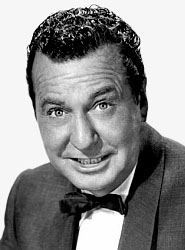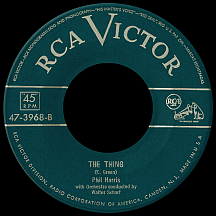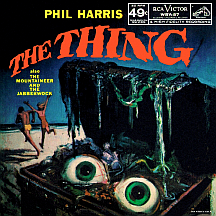PHIL HARRIS
The Thing
Drumming was Wonga Philip Harris's thing when he was a child. In Cherokee, "Wonga" translates roughly as "speedy messenger," a fitting name for one with so much energy to burn. Don't sweat the fact he wasn't Native American (though his family had friends who were); more significant is his birthright, a show-biz kid zealous in his calling. Father Harry Harris was a circus bandleader who later worked in vaudeville and had his son play drums for the ringside extravaganza in 1916, when he was just 12. This exciting time was one of several high points in Phil's life. Over a course of seven decades, he achieved popularity as more than just a musician; he made millions laugh at his antics on radio or while watching him on various-sized screens. He also sold many records, some where he mostly spoke, others where he mostly sang. In a million-selling example of the latter from 1950, he told a funny/scary story about a forbidden box with a..."thing" in it...that latched onto its finder forever!
Harris grew up in Nashville and around 1924, at age 19, he drummed for local favorite Francis Craig's band. Heading west, he joined violinist Henry Halstead and his band in Seattle, banging the skins throughout 1925 and '26 and recording a few sides with Halstead for Victor Records. Afterwards he returned to Nashville and formed his own Dixie Syncopators, playing around the south (and for a time in Hawaii, then a U.S. territory) before heading back to California to head up The Lofner-Harris Orchestra with mustachioed key-tinkler Carol Lofner. In 1929, the band began a three-year residency at San Francisco's St. Francis Hotel (where Halstead had been quite successful pre-Harris). 78s under the Lofner-Harris St. Francis Hotel Orchestra name were released in 1931, including "I Got the Ritz (From the One I Love)" with a lead vocal by Phil.
Lofner departed, taking his paino with him, and Harris started doing his own thing at L.A.'s Cocoanut Grove in the Ambassador Hotel. A couple of 1933 singles on Columbia ("What Have We Got to Lose? (Heigh-Ho Lackaway)" and "How's About It?") credited (bet you've already guessed) Phil Harris and his Cocoanut Grove Orchestra. RKO Radio Pictures showed interest and cast him in a musical short, So This is Harris (the cleverly-edited film won the Academy Award for Best Short Subject, Comedy). It was so popular its director, Mark Sandrich, was assigned a feature-length film, Melody Cruise, also starring Harris, but it lacked much of the bawdy, slapstick humor of its briefer predecessor. In October 1936 he moved to another corner of the entertainment industry, becoming a supporting player on Jack Benny's weekly radio comedy, The Jell-O Program Starring Jack Benny, on NBC. Phil portrayed a heavy-drinking womanizer who spoke in slightly off-color, jive-era slang terms and often used Jack as the butt of his jokes...in other words, he played an exaggerated version of himself. The show made him a nationwide star.
A high-profile role in one of Jack's funniest films, the 1940 western spoof Buck Benny Rides Again, came around the same time Phil recorded "That's What I Like About the South" (for starters, he rhymed 'Alabamy, mammy' and 'hammy'), which became a hit after it was rereleased five years later. His 13-year marriage to Marcia Ralston ended that year and just eight months passed until he married the glamorous Alice Faye, the star of more than two dozen Hollywood films, many of them musicals, the previous seven years. Any "beauty/beast" references evaporated quickly as the couple characterized happiness on all levels. One thing that kept their marriage vibrant was The Phil Harris-Alice Faye Show, a radio comedy that got its start in 1945 as a segment of variety show The Fitch Bandwagon and quickly spun off into a half-hour family sitcom (with young actresses playing their daughters, Alice and Phyllis) that complemented the Benny program on Sunday evenings.

Increased exposure didn't hurt record sales as the public became more accustomed to Phil's public image. Songs were usually of a comedic nature, like "The Dark Town Poker Club" on the ARA label, a rapid-fire reading of gambing den rules '...according to ME!' Others were cute, such as "One-Zy, Two-Zy," a top ten hit in '47 where he teaches his three-year-old daughter Alice to count by adding "z" to everything...people just love that childish stuff! He signed an extensive contract with RCA Victor and one of his best sellers, "Smoke, Smoke, Smoke (That Cigarette)," resonated with his fan base while living in the shadow of the phenomenally hot 1947 original by Tex Williams. Other southern novelties by Phil like "The Preacher and the Bear" and "Is it True What They Say About Dixie" were big during the late 1940s. Occasionally he performed more serious material; there was "Woodman, Spare That Tree" in 1949 and he was one of several artists who had a hit in 1950 with "The Old Master Painter."
Then came his magnum opus of ridiculousness, "The Thing," written by Charles Randolph Grean: '...I saw a great big wooden box a-floatin' in the bay,' opened it and '...discovered a...' (BOOM! BOOM! BOOM!) '...right before my eyes!' He couldn't sell it or give it away: '...this is what he hollered at me as I walked in his shop...ooh, get out of here with that...' (BOOM! BOOM! BOOM!) '...before I call a cop!' Stuck with the thing never mentioned by name: '....one day I came upon St. Peter at the gate...and when I tried to take it inside he told me where to go...get out of here with that...' (BOOM! BOOM! BOOM!) '...and take it down below!' It was funny but a bit disturbing to certain folks, this idea that some-"thing" could latch onto you and never let go. Phil sang the song in the 1951 film The Wild Blue Yonder in a listless way that couldn't compete with radio listeners' imaginations. The song itself was a pop culture phenomenon; the Chicago Coin Machine company made a "Thing" pinball machine with cartoon depictions of the song's various attempts by people to get rid of the box...even a little devil is shown chasing the guy and his box away with his pitchfork!
Many collaborations were recorded with stars of the period, including wife Alice ("The Letter" in 1951) and a crowd-pleasing routine, "The Musicians," with Dinah Shore, Betty Hutton and Tony Martin (also in '51). In 1952 he played second banana to The Bell Sisters on their hit "Hambone." Harris left Jack Benny's radio show at about this time while his sitcom with Alice continued until '54, the year he had a role in the all-star, Cinemascope Oscar winner The High and the Mighty. In 1958, a childen's series 45 of "The Thing" added speeded-up sound effects to the 'BOOM' parts (fitting in with the Chipmunks-fueled craze going on at the time) - there were dog barks, duck quacks and a high-pitched 'Dum-de-dum,' underscored with a subtle altered-time-signature rhythm track. RCA covered all demographics with one of the company's top-selling songs.
At a point when he'd settled into retirement, 63 years old with no designs on working another decade or two, Walt Disney called on Harris for a voice role in his upcoming '67 animated feature The Jungle Book. His characterization of Baloo the Bear made strides towards revolutionizing the approach future actors would apply to animation. Baloo's jive-talking phrases connected with kids and caught the attention of adults bored with the cartoon formula of decades past. "The Bare Necessities," written by folk singer Terry Gilkyson (of "Marianne" fame), became a new signature tune for Phil and received an Oscar nomination for Best Original Song (though some of the magic was lost in Louis Armstrong's performance at the April 10, 1968 Academy Awards show). Harris was called on for more Disney voicework, first in 1970 as Thomas O'Malley Cat in The Aristocats and again in 1974 as another bear, Little John, in Robin Hood. His final film role came in 1991 with Don Bluth's animated Rock-A-Doodle.
Phil Harris and Alice Faye were happily married for more than 53 years, right up to his death in 1995. His career was no less than stellar and several characters he created have left indelible marks for both adults and children. But...according to the lyrics of his biggest hit song...that 'BOOM! BOOM! BOOM!' tune...there are some who believe he still hasn't gotten rid of the thing!



